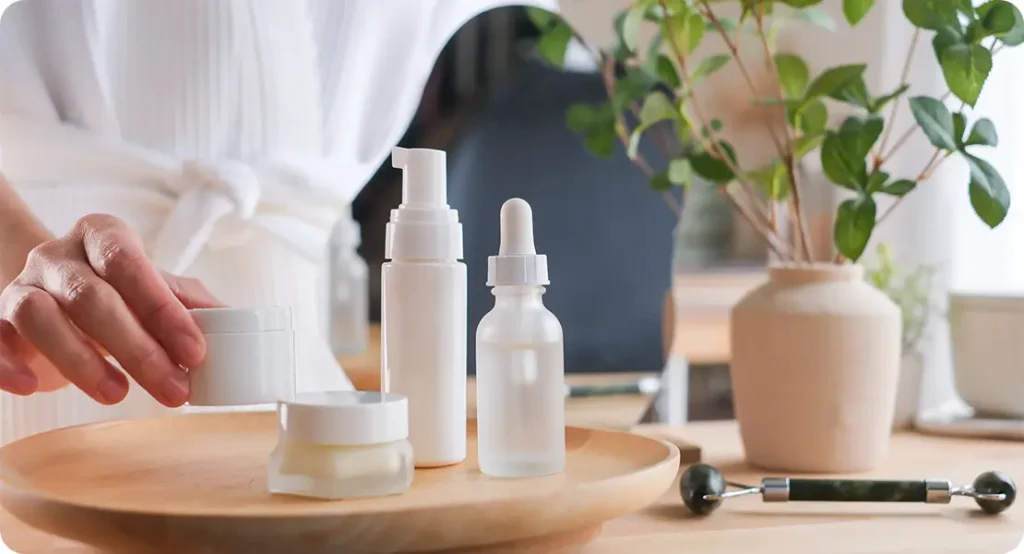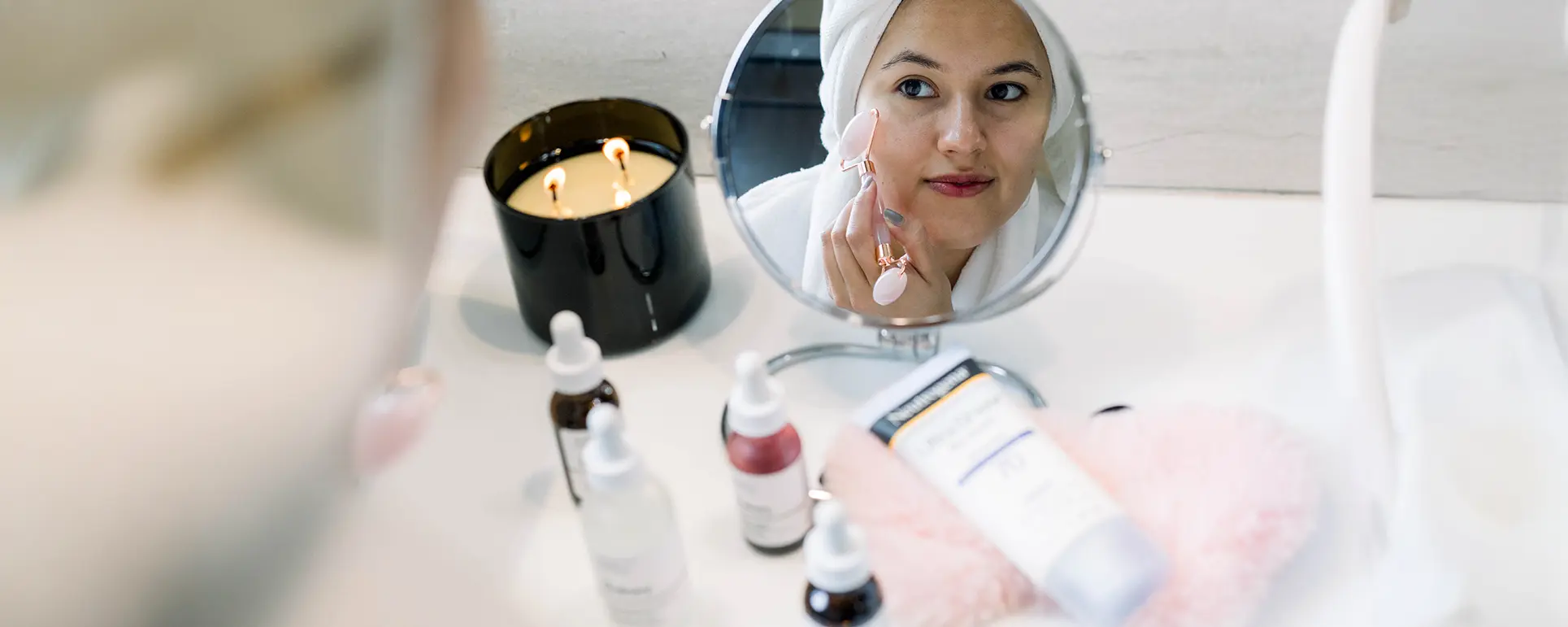Has your skin stopped responding to your go-to skincare products? You’re not imagining it and you’re definitely not alone. What once gave you a radiant, glowing complexion might now leave your skin feeling dull, irritated, dry, or even more breakout-prone. It’s frustrating, especially when you’ve invested time and money into finding products you once trusted. But don’t be too quick to blame the skincare itself. The real issue might be something else entirely: your skin has changed.
According to dermatologists, it’s completely normal for your skin to evolve over time. Factors like age, hormones, weather changes, stress levels, diet, lifestyle habits, and even travel can all impact your skin’s current needs. The moisturiser that kept your face perfectly balanced in the winter may now feel too heavy for the summer months. That exfoliating serum you loved in your 20s might now be too harsh as you move into your 30s or 40s. Likewise, changes in your health such as pregnancy, starting or stopping birth control, or chronic conditions like thyroid imbalances can all affect your skin’s texture, tone, and sensitivity.
When your routine stops working, it doesn’t mean your entire product lineup is worthless. It simply means your routine is overdue for a refresh. Skin thrives on balance and consistency, but it also needs adaptation as circumstances shift. What your skin is craving now could be more hydration, less exfoliation, a gentler cleanser, or better sun protection. In some cases, you may need to stop layering too many actives and focus on repairing your skin barrier first.
Before you panic and overhaul your shelf, take a step back and evaluate. Has the weather changed? Have you switched up your diet or exercise habits? Are you under more stress than usual? These subtle lifestyle shifts can have a big impact on your skin. A dermatologist can help you figure out exactly what’s going on and suggest targeted adjustments without the need to completely reinvent your skincare routine from scratch.
Sometimes, all it takes is swapping a single product or adding one new ingredient to get your skin back on track. The key is listening to your skin, staying flexible, and knowing that skincare isn’t static it should grow with you.
Why Skincare Routines Stop Working
1. Skin Type Evolves
One of the most common and often overlooked reasons your skincare routine stops delivering results is that your skin type has changed. Contrary to what many believe, skin type isn’t fixed for life. It can shift gradually or suddenly depending on a range of internal and external factors. Ageing is a major one: skin that was once oily in your teens or twenties may become combination or even dry as you enter your thirties and forties due to declining oil production and slower cell turnover. Hormonal changes also play a significant role. Puberty, pregnancy, menopause, starting or stopping birth control, or even changes in your menstrual cycle can all influence how much oil your skin produces, how easily it becomes irritated, or how prone it is to breakouts. Likewise, increased stress levels can trigger cortisol spikes, which often lead to flare-ups, excess oil, or inflammation.
Environmental factors are another key influence. If you’ve recently moved to a different climate say, from a humid coastal city to a dry inland region your skin may suddenly need more hydration and barrier support. Seasonal changes can also throw your skin off balance. A routine that works beautifully during the cold, dry winter months might be far too rich or occlusive in the heat and humidity of summer. Diet and lifestyle habits play a part, too. A diet high in processed foods or sugar can lead to inflammation or acne, while regular alcohol consumption or lack of sleep can dehydrate and dull the skin.
If you’ve been using the same routine for years, it’s possible that it’s no longer aligned with your current skin condition. For example, a cleanser designed to control oil might now be stripping your skin if it’s become more dry or sensitive. Or your lightweight moisturiser might no longer provide the level of hydration your maturing skin craves.
That’s why dermatologists recommend re-evaluating your skin type every 6 to 12 months or sooner if you notice sudden changes. Adapting your routine to your current skin type can make a world of difference in how your skin looks and feels.
2. Overuse of Active Ingredients
Think more actives mean better results? Not necessarily. Using too many potent ingredients like AHAs, BHAs, retinoids, or vitamin C can do more harm than good. While these actives are popular for targeting concerns like acne, pigmentation, and ageing, overdoing them can lead to redness, flaking, inflammation, or even a compromised skin barrier. When your skin barrier is damaged, it struggles to retain moisture and defend against external irritants, making your complexion look dull, tired, or even inflamed. It’s easy to get caught up in the latest skincare trends and layer multiple high-strength products, but that doesn’t always translate to healthier skin. In fact, it can leave your skin stressed and more prone to breakouts or sensitivity. The key is balance introduce actives gradually, watch how your skin responds, and don’t be afraid to dial things back. Consulting a dermatologist or skin specialist can help you create a streamlined routine that works with your skin, not against it.
3. Environmental Shifts
Your skin doesn’t exist in a vacuum it reacts to your environment more than you might realise. Seasonal changes, travel, and even subtle lifestyle shifts can dramatically alter what your skin needs. In colder months, the air tends to be dry, and indoor heating only worsens the lack of humidity, leaving your skin parched, flaky, and in need of richer, more nourishing moisturisers. You may also notice increased sensitivity or tightness, which calls for gentler, hydrating products to restore balance.
In contrast, summer often brings humidity, sweat, and increased sun exposure, which can trigger oiliness, breakouts, or pigmentation. That’s when you might benefit from lighter, non-comedogenic moisturisers, mattifying serums, and most importantly a high-SPF sunscreen with broad-spectrum protection.
Travelling to a different climate (like a beach holiday or ski trip) can also confuse your skin. It may not have time to adjust quickly, leading to sudden dryness, congestion, or breakouts. Similarly, lifestyle changes like a new gym routine or a shift in diet can influence how your skin behaves. The key takeaway? Stay flexible with your skincare. Adjust your products based on your current environment, not just your usual routine.
4. Product Expiry or Stability
Skincare products aren’t meant to last forever. Over time, their active ingredients can break down, especially if not stored correctly. Ingredients like vitamin C, for instance, are highly unstable they oxidise quickly when exposed to air, light, or heat, turning yellow or brown and losing their effectiveness. So even if you’re applying it diligently, an oxidised serum might be doing very little or worse, irritating your skin.
The same goes for other common actives like retinol, peptides, and certain botanical extracts. Once past their prime, these products can become less potent, change in texture or smell, or cause unexpected reactions. Expired products may not only fail to deliver results but can also harbour bacteria, especially if they’ve been exposed to warm or humid conditions like a steamy bathroom.
It’s important to check expiration dates, look for changes in colour or consistency, and store your products in a cool, dry place away from direct sunlight. If something smells off or looks different from when you first bought it, it’s better to play it safe and stop using it. Your skin deserves fresh, stable formulations to truly benefit from your routine.
Signs It’s Time to Change Things Up

Not sure if your skincare routine is still doing its job? Your skin will often send clear signals when something isn’t right. Here are some telltale signs it’s time to reassess and possibly refresh your regimen:
- Persistent Breakouts Despite Consistent Care
If you’re following your routine religiously but still dealing with stubborn spots, clogged pores, or acne flare-ups, your products might no longer be effective or they may be too harsh. Sometimes, your skin becomes resistant to certain ingredients, or your needs have simply evolved. A breakout that just won’t clear up may be your skin asking for a gentler, more balanced approach. - Dullness or Rough Texture
When your complexion loses its glow and starts looking flat, tired, or uneven, it’s often a sign that exfoliation or hydration needs adjusting. Your skin might be crying out for more moisture, or perhaps you’ve been skipping exfoliation for too long or overdoing it. Either way, dullness is a red flag that your skin isn’t turning over cells as efficiently as it should. - Sudden Sensitivity to Previously Tolerated Products
If your skin suddenly stings, burns, or gets red after using products that used to feel fine, something has changed. This could be due to a damaged skin barrier, hormonal fluctuations, or environmental stressors. It might also mean your skin has become sensitised from overusing actives. Either way, it’s time to pause, simplify, and rebuild. - Lack of Improvement Despite Regular Use
Skincare takes time, but if you’ve been using a product for months and still see no visible benefit no smoother texture, brighter tone, or fewer breakouts it might be time to try something new. Skin can plateau, and products that once worked wonders may no longer meet your current needs. Don’t be afraid to re-evaluate and adapt.
What a Dermatologist Recommends

If your skincare routine isn’t delivering results or is suddenly making things worse it’s time to press pause and take a more thoughtful approach. Here’s what dermatologists typically advise when your skin seems off track:
- Reassess Your Skin Type
Your skin may not be what you think it is. Many people self-diagnose based on assumptions or outdated information. You might believe you have oily skin when, in fact, it’s dehydrated and overproducing oil to compensate. What appears to be stubborn acne could actually be rosacea, fungal acne, or even a reaction to skincare products. Similarly, flaking or tightness could be early signs of eczema, not just dryness. A professional skin assessment helps you truly understand what’s going on so you can treat it correctly, not just guess. - Simplify Your Routine
One of the most common mistakes dermatologists see? Overcomplicating skincare. Layering too many products especially without understanding their interactions can overwhelm your skin and lead to irritation. Instead, strip it back to the basics: a gentle cleanser, a hydrating moisturiser, and broad-spectrum SPF during the day. Once your skin is calm and balanced, you can slowly reintroduce targeted actives like retinoids, exfoliants, or antioxidants ideally under expert guidance. - Rotate Products Strategically
You don’t need to overhaul your routine every time a new product launches. In fact, constantly switching can confuse your skin and prevent you from seeing real results. What dermatologists recommend instead is strategic rotation. For example, you might use exfoliating acids just twice a week, retinol on alternate nights, and richer creams only during winter. Taking occasional breaks from strong actives can also help your skin recover and perform better long-term. - Prioritise Ingredients, Not Hype
That viral product all over social media? It might work but it might not be right for your skin. Dermatologists encourage focusing on science-backed ingredients like niacinamide (for calming and brightening), hyaluronic acid (for hydration), and ceramides (to strengthen the barrier). These staples are well-researched, gentle, and effective across skin types. Avoid impulse-buying based on trends, especially if you’re dealing with sensitivity, acne, or other ongoing concerns. - Book a Check-In
Skincare isn’t one-size-fits-all. What worked for your friend or even for you six months ago might not be suitable now. If you’re struggling with skin changes, new breakouts, or products that no longer perform, it’s worth consulting a professional. You can get in touch with us to book a consultation with one of our expert dermatologists. A customised treatment plan, based on your skin’s unique needs and lifestyle, can make a world of difference and help you avoid unnecessary trial and error.
Final Thoughts: When to Pivot: Listening to What Your Skin Needs
If your skincare routine no longer gives you the results it once did, don’t worry it’s not a reflection of what you’re doing wrong. Skin changes over time, and your routine should evolve with it. Whether it’s environmental factors, hormonal shifts, or product fatigue, your skin’s needs won’t stay the same forever.
The good news? You don’t have to figure it all out alone. With the right adjustments and a little expert input, you can get back on track. You can get in touch with us to book a consultation with one of our expert dermatologists who can guide you towards a routine that supports your skin as it is right now not as it used to be.
Frequently Asked Questions (FAQs)
- How do I know if my skincare routine has stopped working?
Common signs include persistent breakouts, dull or rough texture, sudden sensitivity to products you’ve used for years, or simply a lack of visible improvement. These changes usually indicate that your skin’s needs have shifted, and it’s time to reassess your routine. - Can I be using the right products but in the wrong way?
Absolutely. Overusing strong actives like retinol or acids, applying products in the wrong order, or mixing incompatible ingredients can all reduce effectiveness or cause irritation. Even great products can backfire without proper usage. - How often should I change my skincare routine?
You don’t need to overhaul your routine frequently, but a seasonal review (every 3–4 months) is wise. Your skin responds to environmental, hormonal, and lifestyle changes, so adapting your products accordingly helps maintain balance and results. - Is it okay to use multiple active ingredients at once?
Only with caution. Some actives complement each other, while others can cause irritation when combined. For example, using vitamin C and AHAs in the same routine can be too harsh. It’s best to introduce new actives gradually and alternate their use. - When should I see a dermatologist about my skincare?
If you’re experiencing unexplained breakouts, persistent irritation, or no improvement after months of consistent use, it’s time to consult a professional. A dermatologist can assess your skin type, identify hidden issues, and create a routine tailored to your needs.
References:
- Yang, J., Tu, Y., Man, M.Q., et al. (2020). Seasonal variations of epidermal biophysical properties in Kunming, China: a self-controlled cohort study. Skin Research and Technology, 26(5), pp.702–707. https://doi.org/10.1111/srt.12857
- Kikuchi, K., Egawa, M. and Iwatsuki, K. (2002). The winter season affects more severely the facial skin than the forearm skin: Comparative biophysical studies conducted in the same Japanese females in late summer and winter. Journal of Dermatological Science. Available at: https://www.researchgate.net/publication/244915196
- Murad Skincare (2023). Skin barrier damage? How to tell if you have it (and how to fix it). Murad WellConnected. Available at: https://wellconnected.murad.com/skin-barrier-damage-how-to-tell-if-you-have-it-and-how-to-fix-it
- Healthline (2020). Yes, retinol is safe when used correctly. Here’s how to get started.
Available at: https://www.healthline.com/health/beauty-skin-care/is-retinol-safe - Allure (2018). How seasonal changes and the weather can affect your skin.
Available at: https://www.allure.com/story/how-seasons-weather-affect-skin
